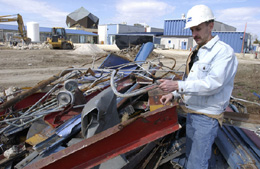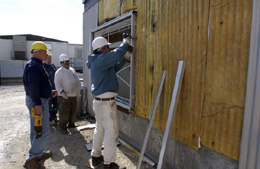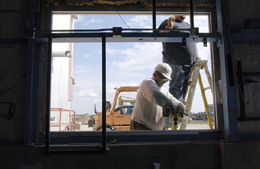 |
|
'Grayfield' Project Has Silver Lining New methods, new funding source serve economy and environment in Technology Campus rehab by Mike Perricone
When it comes to buildings,whatever goes up must usually come down at some point.The question,at a national laboratory with constant budgeting concerns,is just how to tear down a building at the end of its useful life — and,even more important,how to pay for tearing down that building. But a current Fermilab project —the ongoing Technology Campus rehab program in the Fixed Target area —serves as a case study in how cooperation, creative funding from the U.S.Department of Energy,long-term planning and relatively new construction techniques allowed the lab,the environment and a construction contractor all to come out ahead. The story has several beginnings. Fermilab’s first experimental activities,in the 1970s,used a $25-million bubble chamber for neutrino research.The bubble chamber was filled with liquid neon,processed in the Neon Compressor Building.Like the other original experimental buildings in that area,the Neon Compressor Building was a corrugated steel box with a roof.It was significant scientifically and politically —in that Cold War era,scientists from the Soviet Union were among the collaborators —but not aesthetically. Now,more than 30 years later,it has been removed to make room for new space for scientists and engineers in the Particle Physics Division,and for future Fermilab users from across the country and around the world.The building has essentially been deleted:nothing remains,not even the concrete foundation.A similar building nearby,the Laser Building,is next on the list for eradication. “I was a graduate student at Fermilab in 1972-73.I remember taking shifts in the bubble chamber buildings,”recalled John Cooper,now head of Fermilab ’s Particle Physics Division.“And now here I am,watching over the cleanup.” The thinking that led to the cleanup began in 1996.Then-director John Peoples realized that with the end of the original fixed-target program at Fermilab,those original experimental areas could and should be put to new uses.Roger Dixon,head of what was then the Research Division,oversaw the start of construction of the silicon manufacturing buildings and clean rooms. Since then,the lab ’s Facilities Engineering Services Section has worked with PPD to develop a long-range for what was termed the Technology Campus: PPD envisioned its needs for the future,and FESS consulted on how to address those needs piece by piece,as funding became available.Ray Stefanski,then associate director,worked with PPD,FESS and architects Gregory Splinter and Associates of Chicago to develop the initial concept of a “master plan.”The connections between Labs C and D,and between Labs A and B,were completed in accordance with the master plan. In 2001,the plan was revised to reflect changing priorities for the area.The Chicago firm of Holabird and Root was engaged to draw up a visionary architectural rendering for the campus,including grassy areas,sculptures and distinctively shaped buildings.The master plan update was completed in November 2002. “The original model was nice,but expensive,” said David Nevin,head of FESS.“We ’ve deviated somewhat from the original model,but we haven ’t deviated from the concept.When PPD wants to change something,it ’s no longer just an individual piece but part of a larger plan.”
John Cooper,Hans Jostlein,deputy head of PPD,and Ed Crumpley and Steve Dixon, manager and deputy manager respectively of the FESS engineering department,are in constant consultation on the project.But there wouldn ’t be much to consult about if there weren ’t any funding.The story ’s next beginning point shifts to the DOE Office of Science,and to Fermilab Associate Director for Operations Support Jed Brown. Beginning in FY 2002, Congress set aside $10 million for a new Facilities and Infrastructure program to encourage improvements at the DOE Office of Science (SC)laboratories.SC established a new subprogram,Excess Facilities Disposition (EFD),under the Science Laboratories Infra- structure (SLI)program,and dedicated all the funding to removing excess facilities.The news apparently didn ’t travel equally fast in all directions. At a meeting in Washington,D.C.,Fermilab director Michael Witherell heard John Yates of SC ’s Laboratory Infrastructure Division describe this separate funding source for demolition,and had Brown make some follow-up calls. “We never have the money to tear facilities down,” Brown said,spelling out the lab ’s constant funding challenge.“We found a source of money that can ’t be used for anything else.” Brown called the program coordinator,David Michlewicz,at the Lab Infrastructure Division in Germantown,Maryland,and made the connection for Fermilab.Michlewicz visited the site,viewed presentations by FESS,and the funding began coming in. “I had issued a call in FY02 for the labs to identify their needs,”Michlewicz said.“Fermilab came in a little late,and there wasn ’t much money left. But we were able to allocate about $55,000.” That worked out nicely for the Neon Compressor Building.From the $7.9 million in the program for FY03,Fermilab was able to gain about another $330,000 to fund other projects that will be involved in the Technical Campus rehab.More projects have qualified for future funding under the EFD program,although that money hasn ’t been earmarked yet.But the benefits are immediate and substantial. “We get to tear down the buildings,and the money doesn ’t come out of the physics program,”Nevin said. There is another future benefit involving “space banking.”By adding up the square footage from these excess buildings,the lab is building up credit for future construction. “For any projects starting in FY03,”Michlewicz said,“before DOE asks Congress for money for construction,we have to identify an equal amount of excess space to be eliminated.It ’s a zero growth policy that turned excess space into a commodity. If you want to build,you must first identify what you want to tear down.” That means future demolition carried out under the EFD program,for the Technology Campus or other uses,expands the lab ’s ability to put up buildings in the future.For future buildings and projects,the lab is trying to implement the concept of “sustainable design,”integrating the construction and use of a building with its environment (in other words, constructing “greener ”buildings).And beyond banking square footage for EFD credit when buildings are taken down,the lab saves on maintenance,operations and infrastructure it no longer needs to supply for buildings with limited if any use.
The savings extend to the “deconstruction site ” out in the fixed-target area,where Fermilab ’s Stan Boyson is the field manager and construction coordinator.The Technology Campus is described as a “grayfield site,” where rehabilitation will involve the use of some existing buildings,as opposed to a “greenfield ”site,where there are no existing structures.The contractor,Pandecon Construction of Aurora,is recycling about 85 percent of the material from the demise of the Neon Compressor Building,and others to follow.The building is stripped of virtually everything inside before it is taken down.Concrete foundations are smashed and dug up with backhoes.The recycling methods reduce his costs,which in turn reduce the laboratory ’s costs.For Pandecon ’s Friday,April 11,2003 Ron Pansing,recycling is not an idealistic pursuit, but an everyday reality dictated by the economics and logistics of the construction industry. “When I began in general contracting 25 years ago, we might have recycled 20 percent of this material. Most of it was basically buried,”said Pansing,who was also a contractor on construction of Fermilab ’s KTeV experiment in this area of the site. “The economy is driving the recycling movement, and most projects have been done this way for the last three or four years,”Pansing continued. “One reason is that dumps now won ’t accept mixed materials.You can ’t just pile stuff in a dumpster and have it hauled away.But concrete suppliers will break this [concrete ]up and take it away for free,as long as there aren ’t a lot of rebars [steel reinforcing bars ]sticking out of it.So we don ’t have to pay to have it recycled.Since the dumps are now so selective,the dumping fee for this concrete would probably be three times what it cost to get it out of the ground.And the ‘deconstruction ’process doesn ’t really take more time,and it saves costs in demolition.We don ’t have to pay dumping fees, recyclers will provide dumpsters for free as long as you sort the material and load it.Then they ’ll pay you for the material.And the concrete companies will sell you back the crushed concrete as gravel. So it ’s really a good deal.” It ’s a good deal for the environment as well,said Eric Mieland of the lab ’s Environment,Safety and Health Section. “This means we ’re being good stewards of the land,”Mieland said.“We ’re keeping stuff out of landfills,and trying to re-use as much material as possible.We could just abandon everything in place.But that ’s never a good idea because 30 years from now,people won ’t know what ’s been here and what it was used for.It makes more sense to take care of buildings right at the end of their useful life.I ’m very happy to see this kind of paradigm shift.” The story has more beginnings yet to come. When Labs B,E,and G are connected with a new structure,people will move from Wilson Hall into that space.The resulting space in Wilson Hall will go to the U.S.collaboration on the Compact Muon Solenoid detector at CERN,the European Particle Physics Laboratory in Switzerland.Fermilab is the host lab for the US/CMS collaboration. “We ’re hoping researchers will come to Fermilab instead of going to CERN because of the cost of travel,and because of the opportunity to combine their CMS research with work at CDF and DZero,” Cooper said.“The long-term plan at B-E-G calls for courtyards and green grass.I ’d sure like to see the first grass growing out there.”
ON THE WEB: Office of Science Excess Facility Disposition www.science.doe.gov/SC-80/sc-82/efd Office of Science Space Plan Management www.science.doe.gov/SC-80/sc-82/spplan Fermilab Particle Physics Division http://ppd.fnal.gov/ Environment,Safety and Health Section www-esh.fnal.gov |


